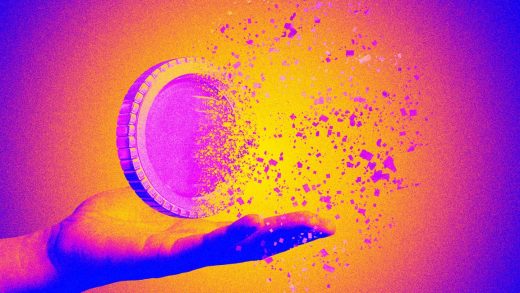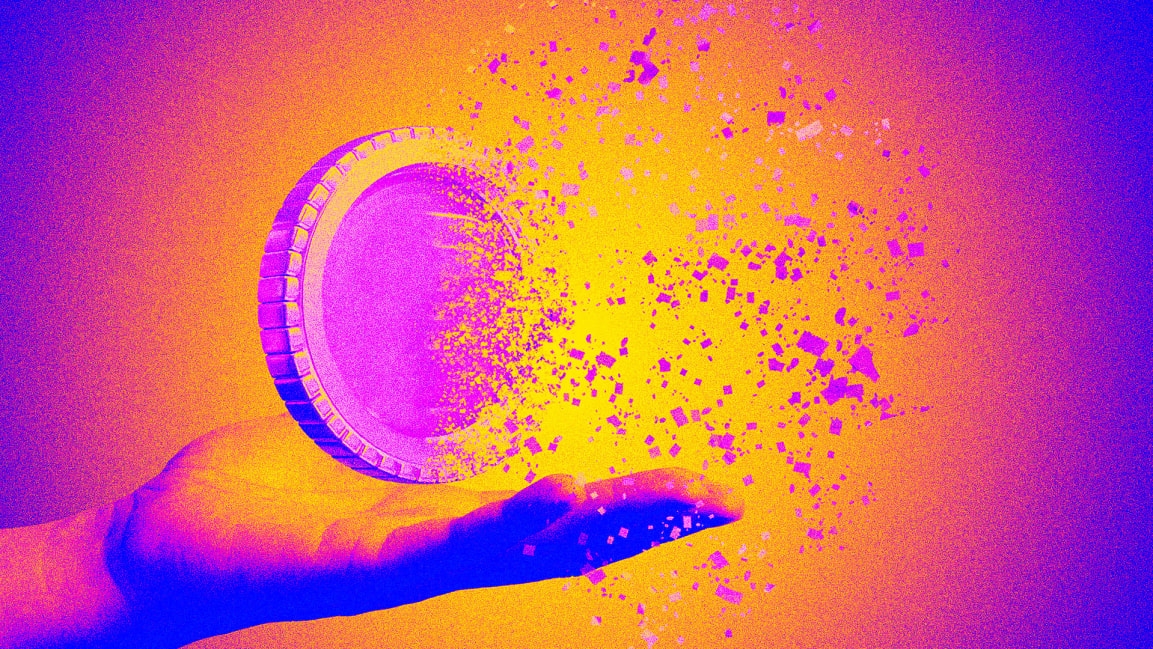As crypto crashes, Terra USD wobbles, shaking the foundations of algorithmic stablecoins
Cryptocurrencies, like most of the stock market today, are cratering amid a storm of geopolitical uncertainties, including COVID shutdowns in China and the ongoing war between Russia and Ukraine.
While some volatile tokens have shed chunks of value—Bitcoin is down over 18% ($7,000) in the past five days and Ethereum is down over 19% ($500)—much of the industry is watching Terra USD, a coin that typically fluctuates by just thousandths of a percent.
That’s because it’s a stablecoin: a cryptocurrency token that’s pegged to the value of a more stable asset like the U.S. dollar, in order to eliminate some of the risks for which crypto is famed. It still offers the perks of a digital coin—near-instant transactions, the privacy and security of a decentralized system—but minus the looming fear of losing half your net worth in minutes, at the whims of a market bulging with prospectors.
However, Terra USD’s foundational stability has been shaken lately, most notably during a weekend stumble that some are now calling a targeted attack on the token.
Confused? Here’s a briefing:
How do stablecoins work?
Stablecoins can hold their pegs in a few ways. They can be backed by other assets, such as other cryptocurrencies; fiat currency; or commodities like gold, oil, or real estate. For example, the leading stablecoin, USD Coin, is backed by the U.S. dollar. Via crypto exchanges, you can trade $1 for 1 USD Coin, which is then minted into existence for you, while the dollar is stored; if you traded it back later, you would be returned a dollar, while the USD Coin is burned into oblivion.
Similarly, gold-backed stablecoins use reserves of precious metal to finance trades. Crypto-backed stablecoins do the same—however, given the volatility of most tokens, a stablecoin backed by, say, Bitcoin must keep a surplus of collateral to ensure a drop in Bitcoin’s value doesn’t also cause a drop in the stablecoin’s value.
But perhaps most intriguing are algorithmic-backed stablecoins—such as Terra USD, which is the third biggest stablecoin by market capitalization.
Rather than keeping reserves, these coins rely on algorithms that maintain a stablecoin’s price similarly to a central bank, which manipulates a fiat currency’s price by controlling the supply of cash. When a stablecoin’s price rises too high, its algorithms mint more tokens to lower its price—or the reverse if the price falls too low. Such moves are all coded into its blockchain’s smart contracts, which execute automatically when specified conditions are met.
How does Terra USD work?
Terra USD (UST) performs this balancing act in tandem with a sister cryptocurrency token called Luna, which is also built on the Terra blockchain. Investors can always exchange 1 UST for $1’s worth of Luna; in doing so, a new Luna coin is minted and the UST is burned away, or vice versa.
Algorithms will execute these trades if necessary. But the dynamic also creates its own system of forces: If UST falls below $1, it presents an arbitrage opportunity for investors to trade their less-than-dollar’s worth of UST for a dollar’s worth of Luna, thus turning a profit. As investors are incentivized to do this, they burn UST, making it more scarce and bringing its price back up. If UST rises above $1, investors can then trade a dollar of Luna for more than a dollar of UST, again ultimately returning the market to equilibrium.
What’s happening now?
Over the weekend, there was a massive surge in UST supply, which caused the price of the token to fall as low as under 99 cents. It was not the first time UST had decoupled from its dollar peg—but it was the first after a new bid to firm up its stability by buying up to $10 billion in Bitcoin, as well as $200 million in Avalanche tokens to use as an extra safety net of reserves.
However, much of the cryptoverse suspects the event to be premeditated, as hundreds of millions worth were dumped in mere moments, along with over $2 billion in withdrawals from Anchor Protocol, essentially a bank for UST that houses much of the $18 billion UST currently in circulation. Meanwhile, the Twitter hashtag #Ponzi began trending, which some now claim was a conspired UST smear campaign. Do Kwon, the founder of UST developer Terraform Labs, reportedly wrote in a since-deleted tweet, “Men will literally attack a stablecoin unsuccessfully instead of going to therapy.”
What’s the fallout?
Some consider it a successful stress test for the stablecoin, as it only lost a fraction of a percent in value before its algorithms began lifting its price back up to safe territory—despite the dramatic catalyst, it was stable again within hours.
But on Monday, UST wobbled again, falling to under 98 cents before recovering midday, causing some to question the mechanisms behind algorithmic stablecoins and their long-term prospects. Simply put, stablecoins aren’t supposed to wobble at all.
However, its troubles could have even graver short-term consequences for the rest of the cryptocurrency market. As UST has struggled to regain its peg, the market has been inundated with Luna—whose price has plummeted, sparking a massive sell-off. Furthermore, fears are growing that Terra could end up selling off its Bitcoin to hold its peg—thus worsening the already grim crypto crash that has vaporized over $200 billion from top tokens in the past week.
(23)



